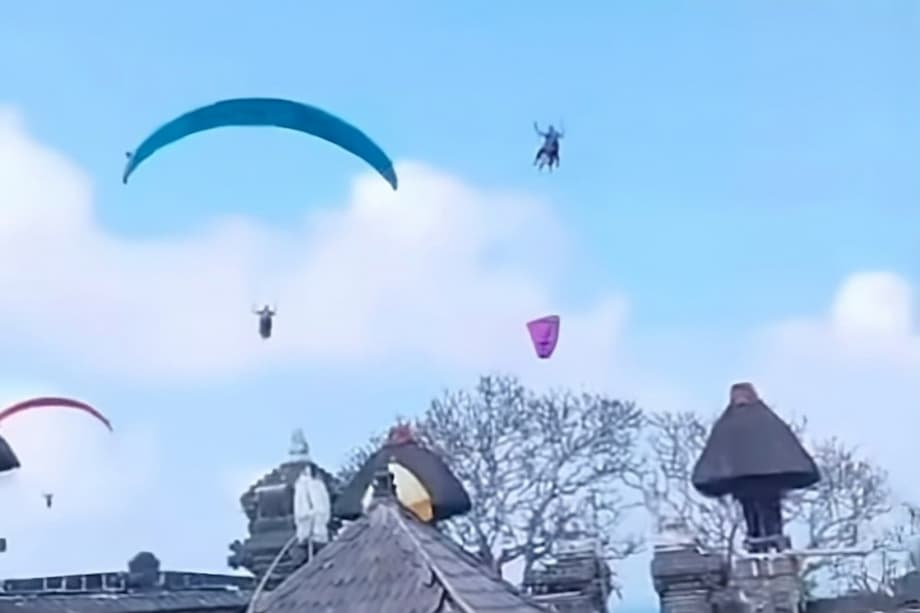Viral Paragliding Video Near Bali Temple Sparks Outcry and Cultural Debate
A recent viral video showing paragliders flying near one of Bali’s most revered temples, Pura Gunung Payung, has ignited a heated debate over tourist conduct, cultural respect, and the regulation of adventure activities on the island. The incident, which quickly spread across social media, prompted swift condemnation from local leaders and the public, raising broader questions about the balance between tourism and the preservation of sacred spaces in Bali.
- Viral Paragliding Video Near Bali Temple Sparks Outcry and Cultural Debate
- Why Is Flying Above Temples So Sensitive in Bali?
- What Actually Happened? Investigations and Clarifications
- Tourism, Adventure Sports, and Sacred Spaces: A Delicate Balance
- Public Reaction: Social Media, Local Voices, and Tourist Perspectives
- Broader Context: Tourism and Sacred Sites Across Indonesia
- What’s Next? Regulation, Education, and the Future of Bali Tourism
- In Summary
The controversy centers on a video posted on August 3, which appears to show a paraglider soaring near the 16th-century Hindu temple perched atop a dramatic cliff in Kutuh Village, South Kuta. For many Balinese Hindus, the act of being physically above a temple—especially during religious ceremonies—is considered deeply disrespectful and offensive. The footage, reportedly captured during a ritual within the temple complex, triggered outrage among cultural leaders and ordinary citizens alike.
Why Is Flying Above Temples So Sensitive in Bali?
To understand the intensity of the reaction, it’s important to appreciate the cultural and religious context of Bali. In Balinese Hinduism, temples (known locally as pura) are not just places of worship but are believed to be the earthly abodes of deities and ancestral spirits. The highest point of a temple is considered the holiest, and tradition dictates that no person or object should be above it, especially during sacred ceremonies. This belief is rooted in the concept of sekala niskala—the seen and unseen worlds—which governs much of Balinese spiritual life.
As explained by Jro Mangku Nyoman Mesir, Head of Kutuh Traditional Village,
“In Balinese Hindu culture, it is considered deeply offensive for anyone to be above the highest point of a temple.”
This cultural norm is so ingrained that even construction and flight paths are carefully regulated to avoid violating the sanctity of temple spaces.
For many Balinese, the viral video was not just a breach of etiquette but a symbolic affront to their spiritual heritage. Senator Ni Luh Djelantik, a prominent member of the Regional Representative Council representing Bali, was among the most vocal critics. She emphasized the need to protect the dignity of Bali’s cultural and religious sites, even as the island continues to welcome millions of tourists each year.
What Actually Happened? Investigations and Clarifications
Amid the uproar, local authorities launched an on-site investigation to determine whether the paragliders had indeed violated the temple’s sacred space. The initial public perception, fueled by the video’s perspective, was that the paragliders had flown directly over Pura Gunung Payung. However, officials later clarified that the flight had occurred outside the designated no-fly zone, and that the apparent proximity to the temple may have been distorted by camera angles and vantage points.
Badung Regent Wayan Adi Arnawa addressed the controversy, stating that while paragliding is not being banned, stricter regulations will be implemented to ensure that flights do not occur above temples. He instructed the Public Order Agency to inspect paragliding businesses in the area and enforce compliance with cultural and safety guidelines.
“The radius will be regulated to prevent flights over temples. Enforcement measures will be taken if necessary,”
he said, underscoring the importance of both tourism and cultural preservation.
The incident also highlighted the challenges of monitoring paragliding activities, as some groups operate independently of local village authorities. Jro Mangku Nyoman Mesir noted that while Kutuh Village has clear standard operating procedures prohibiting flights over the temple, it is difficult to control all paragliding groups, especially those from outside the village. The involvement of the Air Force Base and the Indonesian Aero Sports Federation reflects the seriousness with which authorities are treating the issue.
Tourism, Adventure Sports, and Sacred Spaces: A Delicate Balance
Bali’s popularity as a global tourist destination has brought both economic benefits and cultural challenges. Adventure sports like paragliding have surged in popularity, attracting thrill-seekers eager to experience the island’s stunning landscapes from the air. However, the growth of such activities has sometimes clashed with local customs and religious sensitivities.
Paragliding operators in Bali are typically required to adhere to strict safety and cultural guidelines, including designated flight paths that avoid sacred sites. Yet, as the recent incident demonstrates, enforcement can be complicated by the proliferation of independent operators and the sheer volume of tourists. The Head of Kutuh Traditional Village emphasized that most local operators are aware of and respect these rules, but gaps remain in oversight and accountability.
This is not the first time tourism and culture have come into conflict in Bali. The island has witnessed similar controversies in the past, from inappropriate behavior at temples to disputes over access to sacred sites. The tension reflects a broader global challenge: how to balance the economic imperatives of tourism with the need to protect and honor local traditions.
Safety Concerns and Recent Tragedies
The debate over paragliding near temples comes on the heels of a tragic accident in late July, when two experienced South Korean paragliders died after being swept out to sea near Tanah Barak Beach in the Kutuh Village area. The couple, who had arranged an independent flight, were unable to release their harnesses in time after a sudden wind change forced them into the water. Despite rescue efforts, both lost their lives.
This incident has intensified calls for stricter safety regulations and better oversight of adventure sports in Bali. Authorities have urged tourists to ensure they have comprehensive health and travel insurance, as paragliding is often excluded from standard policies. The tragedy also underscores the risks inherent in adventure tourism and the importance of adhering to established safety protocols.
Public Reaction: Social Media, Local Voices, and Tourist Perspectives
The viral video and subsequent debate have sparked a wide range of reactions, both online and offline. Social media platforms were flooded with comments condemning the perceived disrespect, while others called for greater understanding and dialogue between tourists and local communities.
Senator Ni Luh Djelantik captured the prevailing sentiment among many Balinese when she stated,
“While tourism is important, it is crucial to protect the dignity of the homeland.”
Her remarks reflect a growing awareness among local leaders of the need to balance economic development with cultural preservation.
Tourists, for their part, often express a desire to experience Bali’s unique culture and natural beauty, but may not always be aware of local customs and sensitivities. Online travel forums and review sites reveal a mix of curiosity, confusion, and respect among visitors. Many rely on local guides and tour operators to navigate the island’s complex cultural landscape, while others seek advice on how to avoid inadvertently causing offense.
Services like Bali Holiday Trans, a local driver and tour company, are frequently praised for their professionalism and cultural knowledge. Travelers highlight the importance of having guides who can explain local customs and ensure that tours are conducted respectfully and safely. Such services play a crucial role in bridging the gap between visitors and the communities they encounter.
Broader Context: Tourism and Sacred Sites Across Indonesia
The debate over paragliding near Pura Gunung Payung is part of a wider conversation about the management of sacred sites in Indonesia. Across the archipelago, the influx of tourists has prompted both opportunities and challenges for heritage preservation. The recent controversy over the installation of a stairlift at Borobudur Temple in Central Java, for example, sparked heated debate about accessibility, inclusivity, and the integrity of ancient monuments.
In each case, the underlying issue is how to accommodate the needs and interests of diverse stakeholders—local communities, religious authorities, tourists, and government agencies—while safeguarding the spiritual and cultural significance of these sites. The solutions are rarely straightforward, requiring ongoing dialogue, education, and adaptive management.
What’s Next? Regulation, Education, and the Future of Bali Tourism
In response to the latest controversy, Balinese authorities are moving to tighten regulations around paragliding and other adventure activities near temples. This includes clearer demarcation of no-fly zones, increased monitoring of operators, and stronger enforcement of existing rules. The goal is not to ban paragliding outright, but to ensure that it is conducted in a manner that respects local customs and minimizes risk.
Education is also a key part of the solution. Tourists are being encouraged to learn about Balinese culture and religious practices before participating in activities that may intersect with sacred spaces. Paragliding operators and tour guides are expected to brief clients on appropriate behavior and the importance of respecting local norms. Some travel forums and guide services have begun to include cultural briefings as part of their standard offerings.
Ultimately, the incident serves as a reminder of the delicate balance that must be maintained in destinations like Bali, where the allure of adventure and the sanctity of tradition coexist side by side. As tourism continues to evolve, so too must the frameworks that govern it, ensuring that the island’s unique heritage is preserved for generations to come.
In Summary
- A viral video of paragliders near Bali’s Pura Gunung Payung temple sparked public outrage and debate over tourist conduct and cultural respect.
- Balinese Hindu tradition holds that no person or object should be above a temple’s highest point, especially during ceremonies.
- Authorities clarified that the paragliders did not actually fly over the temple, but the incident revealed gaps in regulation and monitoring.
- Local leaders are calling for stricter rules and better education for tourists and operators to protect sacred sites.
- The controversy highlights broader challenges in balancing tourism, safety, and cultural preservation in Bali and across Indonesia.












